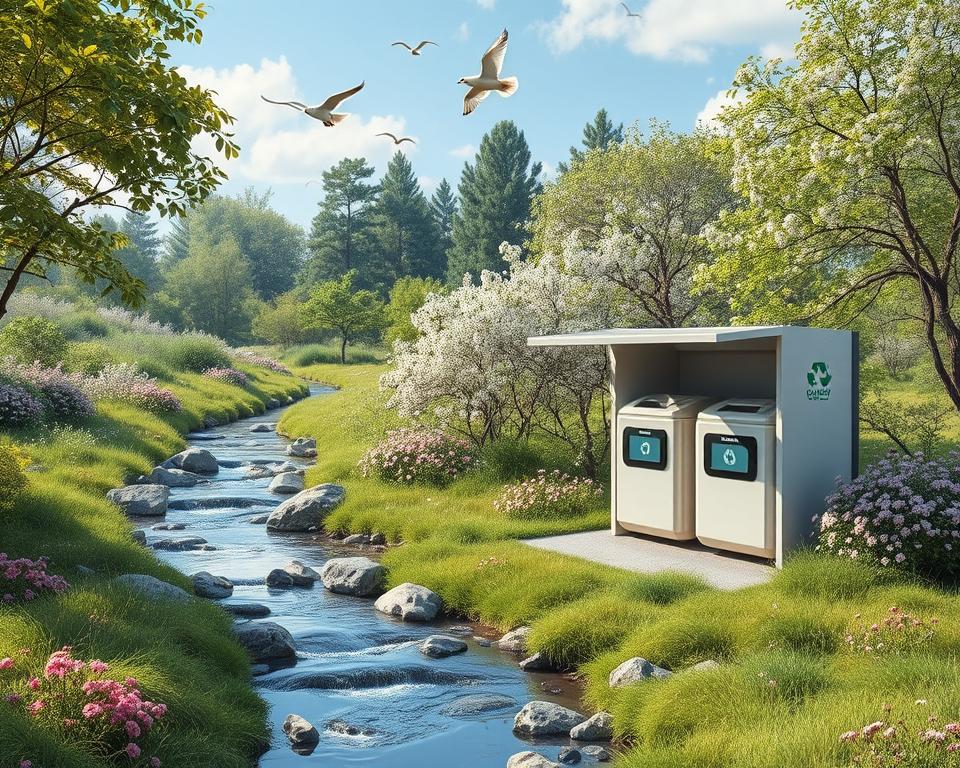Transforming our living spaces is exciting, but disposing of non-woven wallpaper is often overlooked. What if this final step could help our environment? Let’s learn how to dispose of non-woven wallpaper in an eco-friendly way. This ensures our homes are not only beautiful but also help our planet.
Dealing with non-woven wallpaper can seem tough, but it’s a chance to make a difference. In this guide, we’ll explore non-woven wallpaper, its benefits, and how to dispose of it right. We’ll find eco-friendly solutions that make our homes and environment better.
Understanding Non-Woven Wallpaper
Non-woven wallpaper is a modern choice for homes. It combines durability with ease of use. This makes it a favorite among homeowners and designers.
What is Non-Woven Wallpaper?
Non-woven wallpaper is made from synthetic fibers like polyester. It also includes natural materials like cellulose. This mix creates a strong, light, and simple-to-use product.
The Advantages of Non-Woven Wallpaper
Non-woven wallpaper is very durable. It doesn’t tear or peel like old wallpaper. This makes it great for busy areas like hallways and living rooms.
It’s also easy to put up and take down. You can stick it up without messy paste. And when you want to change it, you can remove it without harming the walls.
Lastly, non-woven wallpaper is better for the planet. Its materials can be recycled or composted. This makes it a good choice for those looking for green wallpaper removal solutions.
The Importance of Proper Wallpaper Disposal
Proper disposal of non-woven wallpaper is key for our planet. If not done right, it can harm the environment. Eco-friendly disposal helps keep our planet safe and resources managed well.
Improper disposal can pollute our surroundings. Non-woven wallpaper may have harmful chemicals. These can contaminate soil and water, harming nature.
Wallpaper waste from renovations and new buildings is a big problem. Eco-friendly disposal, like recycling, can help. It reduces landfill waste and supports a green economy.
By focusing on proper disposal, we help the planet. This action is good for the environment and sets a positive example in construction and home improvement.
| Proper Disposal Method | Environmental Impact |
|---|---|
| Recycling non-woven wallpaper | Reduces waste, conserves resources, and promotes a circular economy. |
| Composting wallpaper scraps | Transforms organic matter into nutrient-rich soil, supporting plant growth. |
| Utilizing non-toxic disposal methods | Prevents the release of harmful chemicals, protecting land and water resources. |
Embracing eco-friendly wallpaper disposal is crucial. It helps ensure a better future for our planet.
Preparing for Non-Woven Wallpaper Removal
Before starting wallpaper removal, make sure your workspace is ready. This ensures a smooth and efficient non-woven wallpaper removal process. It also helps avoid messes and damages. Let’s look at the important steps to prepare for this task.
Gather the Necessary Tools
For successful wallpaper removal, you need the right tools. Here are the essentials:
- Wallpaper scoring tool or perforating roller
- Wallpaper stripper solution or spray
- Scraper or putty knife
- Sponge or rag
- Bucket and water
- Protective gear such as gloves and eye protection
Protect Your Surroundings
To keep your space clean and safe, take precautions. Cover the floor with a drop cloth or plastic sheeting. This catches any debris or solution spills.
Also, protect nearby furniture, electronics, and valuables. Cover them to avoid damage. This makes cleanup easier and keeps your space safe.
With a well-prepared workspace and the right tools, you’re ready for a successful wallpaper disposal process. Next, we’ll talk about eco-friendly ways to dispose of your non-woven wallpaper.
Dispose Non-Woven Wallpaper
It’s important to dispose of non-woven wallpaper the right way for the environment and safety. The steps can change based on the wallpaper type and local rules. Let’s look at how to get rid of non-woven wallpaper the right way.
First, make sure to remove the non-woven wallpaper completely from the wall. This is key to avoid problems when you dispose of it. After removing it, you can follow the right steps for disposal.
- Find out from your local waste management what rules are for disposing of non-woven wallpaper waste. Some places have special spots or ways to dispose of it.
- If your area lets you throw non-woven wallpaper in the trash, bag it well. This keeps the environment safe during transport.
- Look into recycling the non-woven wallpaper if your area offers it. This is good for the planet and keeps waste out of landfills.
- If you have a lot of non-woven wallpaper waste, call a waste management company. They can handle it safely and responsibly.
No matter how you dispose of it, always follow local rules and guidelines for proper disposal of non-woven wallpaper. Taking these steps helps the environment and supports sustainable waste management.
Eco-Friendly Wallpaper Disposal Methods
Homeowners are now focusing on making their living spaces more sustainable. This includes how to dispose of non-woven wallpaper in an eco-friendly way. Luckily, there are green alternatives that can lessen the environmental harm caused by this material.
Recycling Non-Woven Wallpaper
Recycling is a top choice for eco-friendly wallpaper disposal. Non-woven wallpaper can be turned into new items, cutting down on waste and saving resources. Here’s how to recycle it:
- Remove the wallpaper from walls carefully, making sure it’s clean and has no leftover adhesive.
- Find a local recycling center or program that takes non-woven wallpaper.
- Wrap the wallpaper well and take it to the recycling place.
Composting Wallpaper Scraps
If you enjoy gardening, composting wallpaper scraps is a great option. Non-woven wallpaper can be composted, turning into soil that’s full of nutrients. To compost it:
- Shred the wallpaper into small bits to help it decompose faster.
- Make sure the wallpaper doesn’t have any chemical adhesives or coatings.
- Add the wallpaper to your compost bin with other organic stuff like food waste and yard clippings.
- Keep an eye on your compost pile, making sure it has the right moisture and air for it to break down well.
By using these sustainable wallpaper recycling and composting methods, homeowners can lessen the non-woven wallpaper environmental impact. This helps make our future greener.
Non-Toxic Wallpaper Disposal Options
Disposing of non-woven wallpaper needs to be done in an eco-friendly way. This helps protect the environment and our health. It’s important to follow non-toxic wallpaper disposal methods and wallpaper disposal practices responsibly.
Recycling is a safe choice for disposing of non-toxic wallpaper. Many recycling centers take non-woven wallpaper. They turn it into new products. This reduces waste and saves resources.
Composting is another good option. Non-woven wallpaper, made from natural fibers, can be composted. Adding it to your compost pile makes nutrient-rich soil for your garden.
If recycling or composting isn’t possible, you can throw it away. But make sure it’s not mixed with harmful materials. This prevents risks during disposal.
Choosing non-toxic wallpaper disposal methods and responsible wallpaper disposal practices helps the environment. Every small step towards responsible disposal makes a big difference.
Responsible Wallpaper Disposal Practices
When we talk about responsible wallpaper disposal, we aim to lessen the harm to our planet. Eco-friendly methods help us move towards a greener future. Let’s look at ways to handle wallpaper disposal better.
Minimizing Environmental Impact
The wrong disposal of non-woven wallpaper can harm our environment. To lessen this harm, follow these steps:
- Reduce Waste: Measure and order the right wallpaper to avoid leftovers.
- Reuse Wallpaper: Find creative uses for leftover wallpaper, like in crafts or as packaging.
- Recycle Wallpaper: Look for local recycling programs that accept non-woven wallpaper.
By using these responsible wallpaper disposal practices, you help reduce the non-woven wallpaper environmental impact. This supports green wallpaper removal solutions.
| Disposal Method | Environmental Impact | Sustainability |
|---|---|---|
| Landfill | High | Low |
| Recycling | Low | High |
| Composting | Minimal | Very High |
By adopting these responsible wallpaper disposal practices, you help reduce the environmental damage. This supports more green wallpaper removal solutions.
Sustainable Wallpaper Removal and Disposal
Responsible wallpaper disposal is key for a clean, sustainable world. By choosing eco-friendly recycling and non-toxic disposal, we reduce waste. This helps our planet.
To remove wallpaper sustainably, start with careful preparation. Use the right tools and protect your space. This makes the removal easier and keeps messes away.
After removing the wallpaper, look into recycling or composting. These options give old materials new life. It’s a great way to reduce waste.
But, eco-friendly wallpaper disposal goes beyond just removal. Think about the long-term effects of your choices. Choose non-toxic disposal that fits your values and helps the environment. By doing this, you help make a better future for your home and community.
FAQ
What is the best way to dispose of non-woven wallpaper?
The best way to get rid of non-woven wallpaper is to do it in an eco-friendly way. You can recycle it, compost it, or use safe disposal methods. This helps protect our environment.
Can non-woven wallpaper be recycled?
Yes, non-woven wallpaper can be recycled. Many places accept it for recycling. There are also special programs for recycling this material.
How can I properly prepare for non-woven wallpaper removal?
To prepare for removing non-woven wallpaper, you’ll need some tools. These include a wallpaper scraper, a water sprayer, and trash bags. Also, cover your floors and furniture to avoid damage.
What are the environmental benefits of proper non-woven wallpaper disposal?
Proper disposal of non-woven wallpaper helps the environment a lot. It reduces waste, saves natural resources, and keeps harmful substances out of our air and water. By choosing sustainable disposal, you help make the world a greener place.
Are there any non-toxic options for disposing of non-woven wallpaper?
Yes, there are safe ways to dispose of non-woven wallpaper. You can recycle it, compost it, or use services that handle non-toxic materials. Avoid burning or throwing it in landfills, as these can harm the environment.





